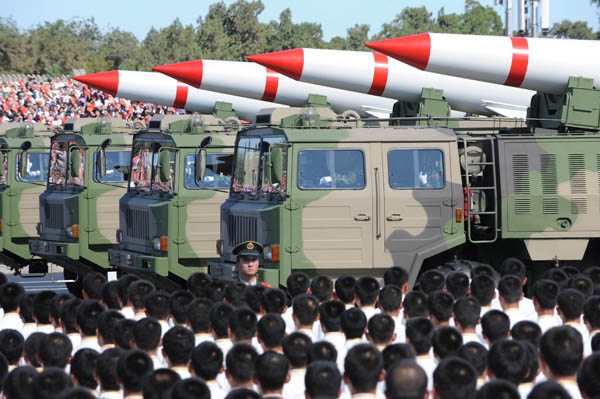A new report by the National Air and Space Intelligence Center warns that China is trying to expand its offensive missile forces and solidify its first-strike advantage in the Western Pacific. According to the report, China “is developing and testing offensive missiles, forming additional missile units, qualitatively upgrading missile systems, and developing methods to counter ballistic missile defenses.” China is adding an array of new short-range missiles capable of striking local and regional targets. In addition, the report notes the deployment of the new DF-21D anti-ship ballistic missile that it designated the CSS-5 as well as a new 2,480-mile range intermediate-range missile.
For some two decades, China has been expanding the quantity and improving the quality of its missile forces, as well as acquiring a number of advanced strike aircraft, some of which can be used to deliver long-range air-to-ground munitions. When taken together, these capabilities give the People’s Liberation Army the capability to deliver a devastating first strike against targets throughout the Western Pacific and to follow up this initial wave with further attacks to prevent recovery. The expanding family of anti-ship cruise and ballistic missiles are meant to prevent U.S. naval forces, particularly carrier battle groups, from moving within range of Chinese targets. The result could be a new Pearl Harbor that essentially disarms the United States and its allies.
The U.S. military has recognized the threat and is beginning to develop responses. The Chief of Naval Operations, Admiral James Greenert, and the Chief of Staff of the Air Force, General Mark Walsh, recently co-authored an article focusing on ways of countering long-range missile threats to U.S. forces. There are a number of ways of reducing the effectiveness of such forces, particularly by interfering with their sensor systems and command and control networks.
But the most important element of a strategy to counter the long-range missile threat, regardless where it exists, must be a countervailing capability consisting of long-range strategic bombers and sea-based cruise missiles. The U.S. Navy maintains an inventory of sea-launched cruise missiles that can be launched both from surface ships and submarines. There have been questions raised regarding the adequacy of the inventory for a serious conflict as well as the ability of current general cruise missiles to penetrate advanced air defenses.
The real hole in the U.S. force structure is the strategic bomber force. Bluntly stated, the force is rapidly aging and in danger of becoming obsolete. The B-52 portion of the force is some 50 years old. The B-1s are in need of technological enhancements in order to ensure their effectiveness even into the next decade. There are fewer than 20 aircraft, the B-2 contingent, capable of penetrating modern air defenses.
The most effective deterrent to the Chinese long-range missile threat is a large and deadly strategic bomber force. Such a force would be based beyond the range of Chinese conventional ballistic and cruise missiles. It would be capable of delivering massive and repeated strikes against PLA forces as well as land-targets. Some portion of this force must be capable of penetrating advanced air defenses to deliver precision strikes against defended and hardened targets. While the Air Force is talking in terms of 80-100 new bombers, it may be necessary to acquire twice that number in order to counterbalance the explosion of Chinese missile forces.
The Air Force is in the early stages of defining the requirements for a new long-range strike system. This may be the most important single program the Pentagon will deal with over the next several decades. It deserves both attention and resources.










